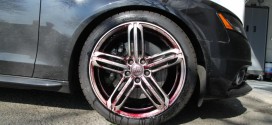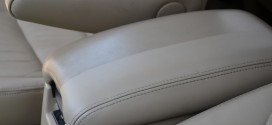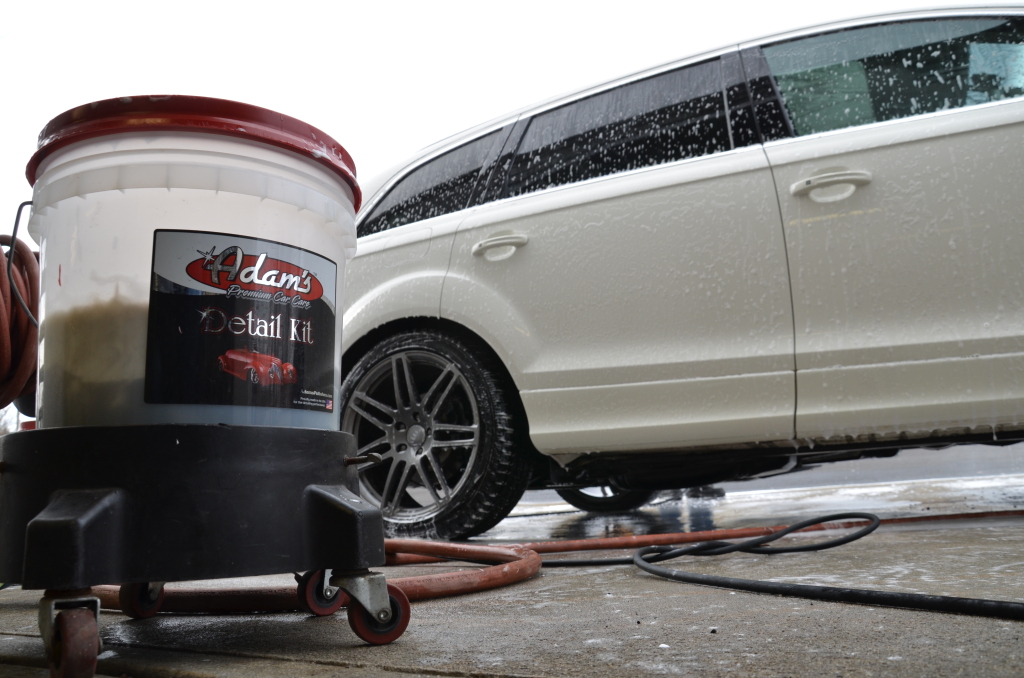Buffer Splatter Prevent this Messy Time Waster…by Kevin Ferrell
LIVING WITH THE PROBLEM
Unfortunately, splatter is so common that some detailers expect it to occur at some point during the buffing process. Detailers live with the problem and cope with splatter in many ways. Some detailers, anticipating the splatter, will take precautions, such as wearing an apron so their shirts and pants don’t acquire that speckled look. Another precautionary measure is covering up problem areas such as the windshield wipers and the cowl area. Does the use of a towel, masking paper, or piece of cardboard sound familiar as a strategy for catching the splatter?
GETTING RID OF IT
Some detailers take the approach that they will just wipe all of the splatter off the car when they’re done buffing. Others will re-wash the entire vehicle. Some will choose to re-buff the splatter. Are any of these methods legitimate fixes for the problem?
Let’s examine these fixes more closely. Covering up problem areas with towels, masking paper, or tape is fine, but also is a bit time-consuming. I personally do not like the idea of draping towels over the windshield wipers or cowl area because the buffing pad may catch the towel and wrap itself around the buffer. This can be very dangerous.
Wiping all of the splatter off the car is extremely time-consuming and may put scratches back into the paint film. If you have been compounding, compound will still be present on the car’s surface, but in a dusty and drier form. Wiping it off with the wrong type of towel, or a very dry towel, may lead to scratches, as well as a vast amount of time wasted trying to get rid of the splatter.
Re-washing the car to get rid of buffer splatter is a huge waste of time. Even after drying it, the vehicle will still drip water from cracks, crevices, and moldings for a long period of time. This may keep wetting the buffing pad in the next buffing step, which may lead to even more buffer splatter. Never re-wash the car unless you absolutely have to!
Some detailers will just re- buff the splatter. This is also not a good idea. There is usually not enough product (in its splatter form) to buff effectively. The product is usually dry and dusty. This is similar to dry buffing, which may lead to swirl marks. If the buffing step you were on happened to be the swirl mark removal process, and you rebuff splatter, you may be putting the swirls back in that you were trying to take out! Never re-buff the splatter! We know the cleanup of all this splatter is a pain, and very timeconsuming. Taking some precautions is sometimes a good idea. However, knowing why and how splatter occurs may help you to prevent it, and not having to worry about cleanups or time-consuming precautions.
WHY DOES THIS HAPPEN?
Buffer splatter occurs for a variety of reasons. Mainly it is caused by an inattentive detailer who is unaware of what is happening as he is buffing a panel. The list begins with simply not paying attention. You run the risk of major splatter if:
1. You do not constantly look at what you are buffing and know where the buffing pad is in relation to the product.
2. You use too much product — the buffing pad does not have a chance to absorb most of it, and the remaining product will get splattered.
3. The buffing pad does not stay flat on the panel being buffed, you leave room for the product to escape in the form of splatter.
4. You start the buffer at too high a speed, or keep it at too high a speed, there is an increased risk of splatter.
5. The buffing pad gets saturated with product, it has nowhere else to go except out of the pad and all over the car.
6. The product itself is too watery or has been mixed with water or a spray shine product to get it to flow better over the panel, it may splatter.
7. You cross the line of product the wrong way with the buffing pad and it does not get “caught” under the buffing pad, it may splatter.
8. You never clean your buffing pad, thereby letting it get to the saturation level, splatter will occur as in example 5. These are some examples of why buffer splatter can occur. Most detailers don’t like the mess and would rather not splatter the product all over the place. Some detailers are aware of this, and employ various methods to prevent splatter, but these methods may not be effective.
PREVENTION GONE WRONG
Car buffing tips
The windshield wiper and cowl area commonly suffer most from splatter
Fear of the dreaded splatter will lead some detailers down a dangerous road of malprevention. Incorrect prevention methods include simply buffing at a very slow speed with the buffer barely spinning. This may prevent splatter, but the car will never be buffed correctly because not enough heat is generated to reflow the clear coat to obtain gloss and remove surface imperfections.
Another prevention method that may be incorrectly implemented is smearing the product on the panel rather than dotting it on or laying down a line of product. While there is far less chance of splatter if the product was smeared on, you are also prematurely drying and evaporating the product on the panel. This will lead to a dry buffing effect, which will lead to swirl marks. Also, smeared-on product is an inadequate amount of product, which will be ineffective, whatever buffing stage you happen to be in.
So, now we know why buffer splatter occurs and some of the non-preferred methods of preventing it. Let’s look at the correct way to prevent it, while ensuring that enough product is available to correctly buff the panel you are working on.
CORRECT PREVENTION
Buffing Pad
The edge of this pad is too wet. Splatter is being flung right off the pad and on to the panel.
If you take your time and pay attention to the buffing process, a large percentage of buffer splatter can be eliminated. However, some precautions must also be taken to ensure a clean, splatter-free buff.
Buffing Pad
Always start with a clean, dry, buffing pad. It should not be wet — not with water, a spray-shine product, previous compound, or polish from another buffing session. Always start the buffer very slowly (less than 1,000 rpm). Work the product into the paint before turning up the speed of the buffer. This will greatly reduce the chances of splattering the product.
Application
Detailing Products
Detailing Training
Applying the product on the panel to be buffed is also a key issue. Some detailers like to “dot” or “dab” the product on the panel. This is fine, as long as it’s done in a consistent pattern on the panel. You don’t want product randomly or haphazardly applied, as this will lead you to “run into” the dots of product with the buffing pad, causing the edge of the pad to hit the product and send it flying or splattering all over. My preferred method of applying the product on the panel is to lay out thin horizontal lines of product and space them far enough apart so the buffer will not inadvertently run over the line of product causing splattering. This will somewhat resemble the yard markers on a football field. The reason I like to apply the product this way is twofold: 1) By laying out lines of product, it will not start to dry and evaporate, thus keeping the product wet enough to have enough flow and do its job correctly. 2) The additional lines, like those of the yard markers on a football field, save me a bit of time as I don’t have to constantly pick up my bottle of product and continually apply it on the car. By having multiple lines of product laid out, I can keep buffing the entire time and develop a flow and pattern to the buffing procedure.
Doing it this way has its drawbacks. With this method, there is quite a bit of product on the panel. A detailer who is not paying attention, or working extremely fast, has a much better chance of splattering the product.
Catch the Product
To “catch” the product correctly and not splatter it, a few things have to happen simultaneously. First, you always want to “catch” the lines of product back into the buffing pad. Since the buffer spins clockwise, the correct way to do this is to move the buffer from right to left and let the product spin back into the center of the buffing pad. Lift up the edge of the buffer very slightly, so that the left side of the pad is angled up a bit. This allows the product to slide under and into the pad, instead of all over the car. If you go the opposite way (left to right), the leading edge of the product has no way to get under and into the pad. This will greatly increase the chance of splatter. Turn the buffer on by triggering it and feathering the speed very slowly. Once the product has been “caught,” and the line of product has disappeared, flatten out the pad and buff the panel. Increase speed gradually and increase the pressure of the pad to the panel you are buffing.
If you have laid out the product in “dot” form, simply place the buffing pad directly over the dab of product and start the buffer slowly, work the product into the panel, and slowly increase speed and pressure.
This method will usually work perfectly when the buffing pad is fresh and clean. As it starts to get a little wet and saturated with product, it becomes more difficult to control splatter. Frequently spur the pad (wool pads) or use a toothbrush (foam pads) to clean the pad and remove the excess product. Also, at this point apply a little less product on the panel because the buffing pad is a bit wet with the product you have been using.
Be careful to keep the product from finding the very edge of the buffing pad. Once you have product on the edge of the pad, the centrifugal force of the spinning pad will fling the product out of the pad and all over the car. Also, do not be afraid to get a brand new pad! At some point the pad will get too wet and the toothbrush method will not be as effective. Have clean, dry pads ready at all times during the day. There is no rule that says you have to use one pad per car, or worse, one pad all day long.
BUFF IN YOUR SUNDAY BEST!
Once you have the procedures and methods of splatter-free buffing honed, wear a suit or tuxedo to work! Show off! There is no need for an apron. You will not get messy! Unless polka dots are a fashion statement, you do not have to be wearing them!
 Detailer's Domain The Source for All Your Car Care Needs
Detailer's Domain The Source for All Your Car Care Needs



